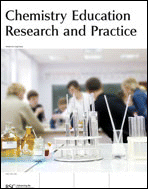Conceptual versus algorithmic learning in high school chemistry: the case of basic quantum chemical concepts. Part 1. Statistical analysis of a quantitative study
Abstract
Part 1 of the findings are presented of a quantitative study (n = 125) on basic quantum chemical concepts taught in the twelfth grade (age 17-18 years) in Greece. A paper-and-pencil test of fourteen questions was used. The study compared performance in five questions that tested recall of knowledge or application of algorithmic procedures (type-A questions) with that on nine questions that required conceptual understanding and/or critical thinking (type-C questions). Performance in type-A questions was relatively high, ranging from 59.2 to 74.4%. With the exception of one double-choice question, performance in the type-C questions was generally much lower, ranging from 11.6 to 37.5%. Results of statistical principal component analysis and of analysis of variance confirmed the division of the questions into the two types, A and C. A large portion of the students (36.8%) could answer only algorithmic questions, while there were few students who exhibited both abilities (6.4%) or only the conceptual one (3.2%). A small proportion (16.8%) of the students could not answer either of the two types of questions. It is concluded that competence in algorithmic problem solving may be independent of competence in conceptual questions. Suggestions for improved instruction are made.

 Please wait while we load your content...
Please wait while we load your content...